Big Ben
![[Big Ben]](http://www.wonderclub.com/WorldWonders/images/BigBen.gif) |
Possibly the most famous clock face and chimes in the world, Big Ben is actually the name of the biggest bell (13.5 tons) inside The Clock Tower (320ft) which forms part of the HOUSES OF PARLIAMENT.
HISTORY
Built in 1858/9 the bell was named after one Sir Benjamin Hall and when it was cast it was Britain's heaviest bell.
Built in 1858/9 the bell was named after one Sir Benjamin Hall and when it was cast it was Britain's heaviest bell.
The clock's four dials each have a diameter of 23ft, the minute hands are 14ft long and the numerals on each face are nearly 2 feet high. The accuracy of the clock movement is controlled by the placing of old pennies in the mechanism.
There is a light at the top of the tower which, when lit, indicates that the House of Commons is sitting. During the day you can tell if they're sitting by looking for a flag at the top of the nearby Victoria Tower which is the tallest and largest of the Westminster towers.
The tower which houses Big Ben has been called by many names, one of the most popular being St Stephen's Tower. However, the official line, from the Head of Public Information at the Palace is that the Clock Tower is simply called The Clock Tower. The subject of John Buchan's "39 Steps", the Clock Tower is unfortunately not open to the public so you won't be able to check how many steps actually lead to the belfry.
The Eiffel Tower
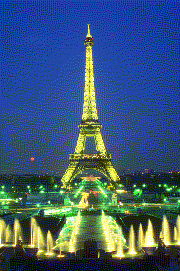 |
HISTORY
The Eiffel Tower was built for the International Exhibition of Paris of 1889 commemorating the centenary of the French Revolution. The Prince of Wales, later King Edward VII of England, opened the tower. Of the 700 proposals submitted in a design competition, Gustave Eiffel's was unanimously chosen.
The Eiffel Tower was built for the International Exhibition of Paris of 1889 commemorating the centenary of the French Revolution. The Prince of Wales, later King Edward VII of England, opened the tower. Of the 700 proposals submitted in a design competition, Gustave Eiffel's was unanimously chosen.
However it was not accepted by all at first, and a petition of 300 names - including those of Maupassant, Emile Zola, Charles Garnier (architect of the Opéra Garnier), and Dumas the Younger - protested its construction.
DESCRIPTION
At 300 metres (320.75m including antenna), and 7000 tons, it was the world's tallest building until 1930. Other statistics include: 2.5 million rivets. 300 steel workers, and 2 years (1887-1889) to construct it. Sway of at most 12 cm in high winds. Height varies up to 15 cm depending on temperature. 15,000 iron pieces (excluding rivets). 40 tons of paint. 1652 steps to the top.
At 300 metres (320.75m including antenna), and 7000 tons, it was the world's tallest building until 1930. Other statistics include: 2.5 million rivets. 300 steel workers, and 2 years (1887-1889) to construct it. Sway of at most 12 cm in high winds. Height varies up to 15 cm depending on temperature. 15,000 iron pieces (excluding rivets). 40 tons of paint. 1652 steps to the top.
It was almost torn down in 1909, but was saved because of its antenna - used for telegraphy at that time. Beginning in 1910 it became part of the International Time Service. French radio (since 1918), and French television (since 1957) have also made use of its stature.
During its lifetime, the Eiffel Tower has also witnessed a few strange scenes, including being scaled by a mountaineer in 1954, and parachuted off of in 1984 by two Englishmen. In 1923 a journalist rode a bicycle down from the first level. Some accounts say he rode down the stairs, other accounts suggest the exterior of one of the tower's four legs which slope outward.
The tower has three platforms. A restaurant (extremely expensive; reservations absolutely necessary), the Jules Verne is on the second platform. The top platform has a bar, souvenir shop, and the (recently restored) office of Gustave Eiffel.
The Gateway Arch
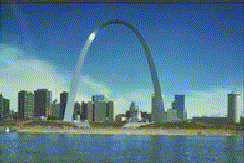
The Aswan High Dam
 |
LOCATION
The High Dam is located just south of the city of Aswan in Egypt.
The High Dam is located just south of the city of Aswan in Egypt.
HISTORY
The High Dam was constructed not only to regulate the yearly flood of the Nile, but also to create a water reservoir capable of storing water to prevent famine during severe droughts. Construction of the Dam began in 1960 as a national project, undertaken by Egyptian president Nasser who nationalized the Suez Canal to provide funds for the project. With the American and the British refusing to secure a loan for the construction, it was the Soviets that designed the earth structure and provided the equipment required to build the power station. During the course of construction, provisions were made to repatriate the Nubian inhabitants, and, in a multi-national effort, to relocate The Great Temple of Abu Simbel.
The High Dam was constructed not only to regulate the yearly flood of the Nile, but also to create a water reservoir capable of storing water to prevent famine during severe droughts. Construction of the Dam began in 1960 as a national project, undertaken by Egyptian president Nasser who nationalized the Suez Canal to provide funds for the project. With the American and the British refusing to secure a loan for the construction, it was the Soviets that designed the earth structure and provided the equipment required to build the power station. During the course of construction, provisions were made to repatriate the Nubian inhabitants, and, in a multi-national effort, to relocate The Great Temple of Abu Simbel.
In 1970, the Aswan High Dam was inaugurated by president Sadat. Today, the reservoir known as Lake Nasser spans approximately 500 kilometers across the Egyptio-Sudanese border. In spite of the ecological problems caused by the dam, it has been a blessing to the Egyptian community. It left the country unaffected by the drought that hit Africa during the late 1980's, and, in the 1990's, spared Egypt several unexpectedly high floods. A regulated agricultural system is now in place, and, in 1996, for the first time, the water in Nasser Lake rose above the spill level. Plans are underway to populate the area along the spillway of Toshka and to create new communities along the recently constructed Zayed Canal in the heart of the Sahara Desert.
The Hoover Dam
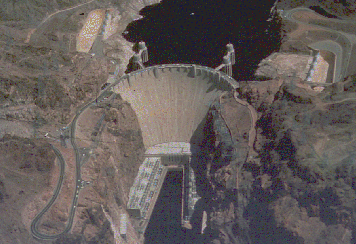 |
Human beings have lived along or near the Colorado River for thousands of years. The evidence for this is the hundreds of habitation sites found throughout the Las Vegas, Lake Mead, Hoover Dam and Lake Mojave area, many of which have been dated with radiocarbon, argon, or by other measures.
Some of the earliest peoples have been called "desert culture" people, basket makers, or pueblo people. It is important to remember that these names are just a convenience for those who study people and their way of life. These are not names that the people have given themselves.
The descendants of the early peoples we know by more familiar names -- Paiutes, Hopi, Mojave, Yuma, Havasupai, Hualapai. These names are the names which the people have given to themselves -- for example, Havasupai means "the people of the blue-green water".
The first non-native people in the Colorado River area were Spanish conquerors (conquistadores), who were looking for gold, silver or other wealth. Ulloa was the first to see the mouth of the Colorado in 1539. Cardenas, who traveled with Coronado from Mexico in 1540, was the first to see the Grand Canyon. Some of these Spanish soldiers stayed or returned to live in the area, which is why the Spanish language is so widely used today in California, Arizona, New Mexico and Nevada.
The sharing of languages was not the only effect of contact between Spanish soldiers and native people. Foods, diseases, tools, horses, and a great blending of cultures was the ultimate result of the initial, sometimes unfriendly, contacts.
Some two hundred years after the conquerors came, Spanish priests, such as Fathers Dominguez and Escalante in 1776, entered and explored parts of the Colorado River basin as they looked for routes of travel between their missions. It was Father Garces, also in 1776, who named the river, Rio Colorado, "river colored red."
Jedediah Smith and other trappers came looking for beavers in 1826, gold miners on the way to California followed in 1849, and Mormon settlers arrived in Las Vegas in 1855. Las Vegas, which is Spanish for "the meadows," did not become a town until 1905.
River explorers and mappers first came in January, 1858, under the leadership of Lt. Joseph Christmas Ives, who came up the Colorado by steamboat from the Gulf of California. He traveled as far upriver as possible to Black Canyon, the eventual site of Hoover Dam. John Wesley Powell and his men floated down the river, starting on the Colorado's main tributary, the Green River. From Green River, Wyoming, he and his men rowed all the way through the Grand Canyon. Powell made a second trip down the Colorado in 1871.
The river explorers were hoping to find that the Colorado could be used as a route of travel and commerce, but because of the wide fluctuations in the amount of water from season to season, they concluded that it could not.
The dam builders came in 1931. A handful of men did the planning and designing of the dam. There were another 16,000 workers who did the actual building. Many of these men had families, wives and children, who came with them.
Why would so many people come out to what was, at the time, a raw, undeveloped and dangerous place to live? Essentially, because of the terrible economic times, the Depression, that was then affecting almost every part of the United States. People came from every part of the country to work at Hoover Dam.
The way of life so many people had to endure -- camping out in tents or shacks along the Colorado River, some for as long as three years, without clean drinking water, toilets, or protection from the extreme weather -- makes these "common" people the real heroes of Hoover Dam.
96 men were killed in industrial accidents while building the dam. Several dozen others died from the heat or carbon monoxide poisoning while on the job, and hundreds of other people, wives and children of the workers, died from heat, polluted water or disease.
Because of Hoover Dam, the Colorado River was controlled for the first time in history. Farmers received a dependable supply of water in Nevada, California and Arizona. And Los Angeles, San Diego and Phoenix and a dozen other towns and cities were given an inexpensive source of electricity, permitting population growth and industrial development. Mount Rushmore
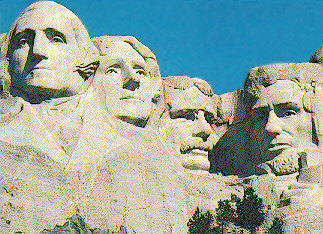 |
This epic sculpture links the faces of four exalted American presidents: Washington, Jefferson, Teddy Roosevelt, and Lincoln. South Dakota's Black Hills provide the back-drop for Mount Rushmore, the world's greatest mountain carving. These 60-foot high faces, 500-feet up, look out over a setting of pine, spruce, birch, and aspen in the clear western air.
Sculptor Gutzon Borglum began drilling into the 6,200-foot mountain in 1927. Creation of the Shrine to Democracy took 14 years and cost a mere $1 million, though it's now deemed priceless.
Throughout 1998, Mount Rushmore National Memorial will celebrate the culmination of a multi-million dollar public-private partnership project to improve visitor facilities at the Memorial. Events throughout the year will offer the public exciting opportunities to come enjoy the new facilities at Mount Rushmore.
The park has recently installed the new Avenue of Flags, leading from the Concession Building to the Grandview Terrace. The flags of the 56 states and territories again fly below the Memorial. The Avenue provides direct and easy access to the Grandview Terrace and Presidential Trail, offering spectacular views of the mountain sculpture.
The 1998 summer season will also include an expanded interpretive program that extends through September. In addition to the exhibits and film at the new Lincoln Borglum Visitor Center, rangers will be providing more interpretive walks and talks. Interpretive programs, including the Evening Sculpture Lighting Ceremony, will continue through September. The lighting program will take place at 9 p.m. nightly in the park's amphitheater. This year the amphitheater is fully accessible via the Avenue of Flags to elevators at the new Visitor Center.
Other programs being offered include guided walks to the Sculptor's Studio, Presidential Trail walks, talks on the Grandview Terrace, afternoon children's activities and studio talks. Please check at the park's Visitor Center or call the park at (605) 574-2523 for times of these activities.
The Petronas Towers
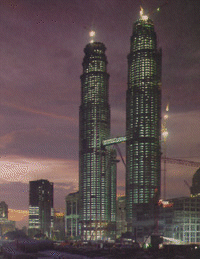

No comments:
Post a Comment